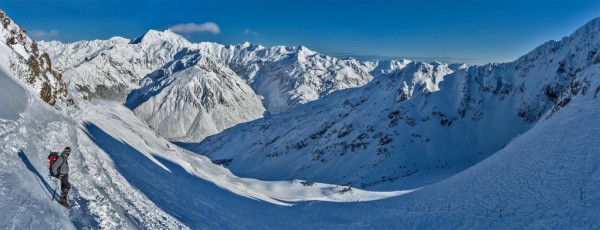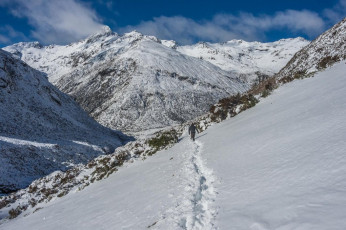
We were feeling optimistic as we drove from Christchurch across to Arthurs Pass. The weather was beautiful and the forecast indicated four very settled days around Arthurs Pass – we couldn’t believe our luck. But there had been heavy recent snowfall and the considerable risk of avalanches. So on arrival at Arthurs Pass we contacted one of the local alpine oracles to seek his advice. According to his extremely helpful website www.arthurspass.com, Graeme Kates is an ugly bugger who has lived at Arthurs Pass for the last 21 years.
This image - Mt Rolleston at dawn

Graeme confirmed our avo concerns and suggested that we give Rolleston a couple of days to firm up, also indicating that conditions might be a little better above Temple Basin. Good idea - a warm up on a traverse from Temple Col, over Mount Temple to Mount Phipps we thought.

Next morning before dawn, Steve and I began our slog up to Temple Basin. It was chilly but a lovely clear morning. Just enough clouds to catch the warm colours of the rising sun and, as we ascended, an ever improving view of Rolleston across the valley. Graeme had suggested that we keep an eye on Rolleston to see what its upper slopes looked like as the day wore on.
To begin with, Rolleston was a huge lump of ice cream, glowing orange and then transforming into vanilla. A lot of snow, that hopefully the sun would melt; and then the coming clear cold night would freeze nicely. So we thought at least.
This image - above the ski field and below Temple Col

After checking in with the Ski Patrollers at Temple Basin we cramponed on up towards Temple Col. For the most part crampons weren’t necessary in the deep snow, but we figured things might firm up higher. Across the valley Rolleston disappeared as clouds began gathering around the tops. Hmm, rather than melting, it appeared that a further dusting of snow was being dropped on top of what was already there. Somewhat at odds with the glowing weather forecast, but what we have to expect living on an island.

From Temple Col it was evident that the eastern aspect was heavily snowed in. Our ridge route went directly north and up; and even that required waist deep plugging to start with.

The ridge narrowed to a knife edge before broadening out again as we pitched and simul-climbed our way to the summit of Mount Temple, just half a km along and 140m above the Col. Even so, it took us a lot longer to reach the top of Temple (1,913m) than we had thought and, with heavy cloud closing in, we had to concede that Phipps would have to wait for another day. Lesson number one – how you interpret the map doesn’t always translate to reality. Still, excellent practise and a fun day out.

Pitching up unstable snow just beneath the summit of Mount Temple

Company back on Temple Col – eyeing up the ‘gagging to be unravelled’ yellow thing

Back at Arthurs Pass we checked in with the Oracle, who concurred with what we had found – loads of unconsolidated snow requiring a bloody good freeze before we could get up much. So, next day we took it easy, had a couple of nice flat whites at the cafe and then went for a look-see up the Otira Valley. Fresh tracks didn’t extend far and soon we were knee deep and plugging our way over the bridge and on up to about 1,200m. We got a great view back to Mounts Temple and Phipps; and figured that this would set us up nicely for a climb tomorrow. Surely the now completely clear weather would see a good freeze over night. Surely!

Next morning, before dawn under a crystal and starry sky, we made quick progress back along our track, until Steve started to struggle. Steve never struggles. He’s one of those quiet, totally dependable types that just gets on with it. But this morning he was suffering from a nasty dose of heart burn. Perhaps back at the pub the evening before, the giant pizza we ate, along with maybe an extra glass of vino than was smart, were taking their toll. Lesson number two – on a climb never discount the unlikely.

I forged ahead to break trail while Steve beat off his gastro demons. At the end of our tracks of the day before I soon realised that the going under foot had not improved in the slightest, despite the lovely clear night. In fact, it just got worse as we headed up.

By 10am we found ourselves sitting on a boulder near the head of Otira stream, in beautiful sunshine, under a cobalt sky. We were on an island surrounded by waist deep unconsolidated powder with zero base. Hidden holes into rock and tussock cracks everywhere.
How could this be? There had been no freeze at all, despite the cold clear night. Well, the snow was so dry that it wouldn’t freeze. The melt we needed had not happened the day before and, here we were, still with a good eight hours of blue bird daylight, about to throw in the towel. Bugger and double bugger. Lesson number three - blue bird conditions are no guarantee of success on the hill.

After an early lunch we plunged back into the powder and began a snow plough, this time back along the stream bed, hoping it might be more interesting than retracing the higher route we had taken on the way in, so as to avoid deep snow in the stream bed. Oh yeah, deep snow in the stream bed. And of course, that’s what we did encounter.
This image - When a climb becomes a swim – at our reluctant turn around point

As we fought our way past a section of large boulders and water fall a small figure emerged further down valley, tracing our track. As we converged, a weather beaten face with a mop of sun bleached, wind blown hair came into focus. It had to be our Oracle, whom we had only spoken with by phone until then. Definitely rugged, but “ugly“, as his website claimed, was a bit harsh I thought.

Graeme was aiming to reach 1,500m – about 200m higher than we had reached, so he could dig some pits to update his snow condition report. He assured us that conditions were bad, which made us feel a bit better about retreating in such fabulous weather.
This image - Punch Bowl waterfall – a nice diversion when waiting for conditions to improve

Later, back in Wellington, I received an email from Graeme. He explained how he had not been able to reach 1,500m before avalanches started letting loose around him. On his retreat he then fell into a three metre hole, in hidden frozen avo debris, becoming mildly hypothermic as he struggled to extract a snowshoe-clad and tightly wedged foot. Lesson number four – if it’s clearly iffy, best not to push it. The mountains aren’t going anywhere.









